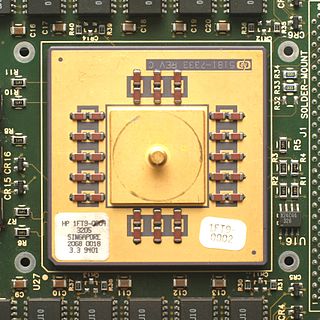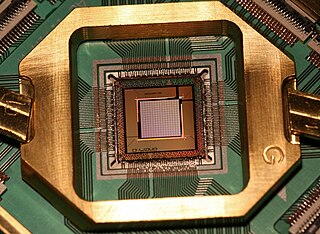Related Research Articles

A central processing unit (CPU)—also called a central processor or main processor—is the most important processor in a given computer. Its electronic circuitry executes instructions of a computer program, such as arithmetic, logic, controlling, and input/output (I/O) operations. This role contrasts with that of external components, such as main memory and I/O circuitry, and specialized coprocessors such as graphics processing units (GPUs).
Processor design is a subfield of computer engineering and electronics engineering (fabrication) that deals with creating a processor, a key component of computer hardware.

The StrongARM is a family of computer microprocessors developed by Digital Equipment Corporation and manufactured in the late 1990s which implemented the ARM v4 instruction set architecture. It was later acquired by Intel in 1997 from DEC's own Digital Semiconductor division as part of a settlement of a lawsuit between the two companies over patent infringement. Intel then continued to manufacture it before replacing it with the StrongARM-derived ARM-based follow-up architecture called XScale in the early 2000s.

Complementary metal–oxide–semiconductor is a type of metal–oxide–semiconductor field-effect transistor (MOSFET) fabrication process that uses complementary and symmetrical pairs of p-type and n-type MOSFETs for logic functions. CMOS technology is used for constructing integrated circuit (IC) chips, including microprocessors, microcontrollers, memory chips, and other digital logic circuits. CMOS technology is also used for analog circuits such as image sensors, data converters, RF circuits, and highly integrated transceivers for many types of communication.

Stephen Byram Furber is a British computer scientist, mathematician and hardware engineer, currently the ICL Professor of Computer Engineering in the Department of Computer Science at the University of Manchester, UK. After completing his education at the University of Cambridge, he spent the 1980s at Acorn Computers, where he was a principal designer of the BBC Micro and the ARM 32-bit RISC microprocessor. As of 2018, over 100 billion copies of the ARM processor have been manufactured, powering much of the world's mobile computing and embedded systems.

The Department of Computer Science at the University of Manchester is the longest established department of Computer Science in the United Kingdom and one of the largest. It is located in the Kilburn Building on the Oxford Road and currently has over 800 students taking a wide range of undergraduate and postgraduate courses and 60 full-time academic staff.
Asynchronous circuit is a sequential digital logic circuit that does not use a global clock circuit or signal generator to synchronize its components. Instead, the components are driven by a handshaking circuit which indicates a completion of a set of instructions. Handshaking works by simple data transfer protocols. Many synchronous circuits were developed in early 1950s as part of bigger asynchronous systems. Asynchronous circuits and theory surrounding is a part of several steps in integrated circuit design, a field of digital electronics engineering.
In digital logic design, an asynchronous circuit is quasi delay-insensitive (QDI) when it operates correctly, independent of gate and wire delay with the weakest exception necessary to be turing-complete.
The asynchronous array of simple processors (AsAP) architecture comprises a 2-D array of reduced complexity programmable processors with small scratchpad memories interconnected by a reconfigurable mesh network. AsAP was developed by researchers in the VLSI Computation Laboratory (VCL) at the University of California, Davis and achieves high performance and energy-efficiency, while using a relatively small circuit area. It was made in 2006.

The NEC V60 is a CISC microprocessor manufactured by NEC starting in 1986. Several improved versions were introduced with the same instruction set architecture (ISA), the V70 in 1987, and the V80 and AFPP in 1989. They were succeeded by the V800 product families, which is currently produced by Renesas Electronics.

The history of general-purpose CPUs is a continuation of the earlier history of computing hardware.

The Manchester computers were an innovative series of stored-program electronic computers developed during the 30-year period between 1947 and 1977 by a small team at the University of Manchester, under the leadership of Tom Kilburn. They included the world's first stored-program computer, the world's first transistorised computer, and what was the world's fastest computer at the time of its inauguration in 1962.
The SPARC64 V (Zeus) is a SPARC V9 microprocessor designed by Fujitsu. The SPARC64 V was the basis for a series of successive processors designed for servers, and later, supercomputers.

The PA-7100 is a microprocessor developed by Hewlett-Packard (HP) that implemented the PA-RISC 1.1 instruction set architecture (ISA). It is also known as the PCX-T and by its code name Thunderbird. It was introduced in early 1992 and was the first PA-RISC microprocessor to integrate the floating-point unit (FPU) on-die. It operated at 33 – 100 MHz and competed primarily with the Digital Equipment Corporation (DEC) Alpha 21064 in the workstation and server markets. PA-7100 users were HP in its HP 9000 workstations and Stratus Computer in its Continuum fault-tolerant servers.
The Berkeley IRAM project was a 1996–2004 research project in the Computer Science Division of the University of California, Berkeley which explored computer architecture enabled by the wide bandwidth between memory and processor made possible when both are designed on the same integrated circuit (chip). Since it was envisioned that such a chip would consist primarily of random-access memory (RAM), with a smaller part needed for the central processing unit (CPU), the research team used the term "Intelligent RAM" to describe a chip with this architecture. Like the J–Machine project at MIT, the primary objective of the research was to avoid the Von Neumann bottleneck which occurs when the connection between memory and CPU is a relatively narrow memory bus between separate integrated circuits.

SpiNNaker is a massively parallel, manycore supercomputer architecture designed by the Advanced Processor Technologies Research Group (APT) at the Department of Computer Science, University of Manchester. It is composed of 57,600 processing nodes, each with 18 ARM9 processors and 128 MB of mobile DDR SDRAM, totalling 1,036,800 cores and over 7 TB of RAM. The computing platform is based on spiking neural networks, useful in simulating the human brain.

Simon Anthony Segars is the former chief executive officer (CEO) of ARM Holdings plc from 2013 to 2022. ARM is the UK-largest semiconductor IP company headquartered in Cambridge, England, and was acquired by SoftBank Group for £24.3 billion in 2016.

The Josephson junction count is the number of Josephson junctions on a superconducting integrated circuit chip. Josephson junctions are active circuit elements in superconducting circuits. The Josephson junction count is a measure of circuit or device complexity, similar to the transistor count used for semiconductor integrated circuits.
Signal Transition Graphs (STGs) are typically used in electronic engineering and computer engineering to describe dynamic behaviour of asynchronous circuits, for the purposes of their analysis or synthesis.
References
- ↑ The Advanced Processor Technologies Group Archived September 28, 2009, at the Wayback Machine . Intranet.cs.man.ac.uk. Retrieved on 2013-06-14.
- ↑ Furber, S.B.; Day, P.; Garside, J.D.; Paver, N.C.; Woods, J.V. (1994). "AMULET1: A micropipelined ARM". Proceedings of COMPCON '94. IEEE. pp. 476–485. doi:10.1109/cmpcon.1994.282880. ISBN 978-0818653803. S2CID 14245464.
- ↑ Woods, J.V.; Day, P.; Furber, S.B.; Garside, J.D.; Paver, N.C.; Temple, S. (April 1997). "AMULET1: an asynchronous ARM microprocessor". IEEE Transactions on Computers. 46 (4): 385–398. CiteSeerX 10.1.1.673.3262 . doi:10.1109/12.588033. ISSN 0018-9340.
- ↑ Furber, S.B.; Day, P.; Garside, J.D.; Paver, N.C.; Temple, S.; Woods, J.V. (1994). "The design and evaluation of an asynchronous microprocessor". Proceedings 1994 IEEE International Conference on Computer Design: VLSI in Computers and Processors. IEEE Comput. Soc. Press. pp. 217–220. doi:10.1109/iccd.1994.331891. ISBN 978-0818665653. S2CID 14055669.
- ↑ The Advanced Processor Technologies Group Archived September 28, 2009, at the Wayback Machine . Intranet.cs.man.ac.uk (1996-10-02). Retrieved on 2013-06-14.
- ↑ The Advanced Processor Technologies Group Archived September 28, 2009, at the Wayback Machine . Intranet.cs.man.ac.uk. Retrieved on 2013-06-14.